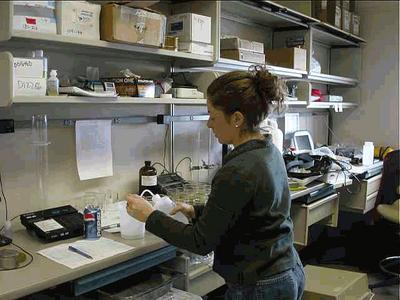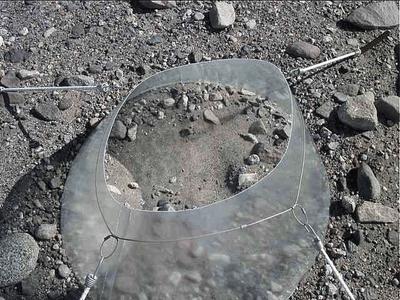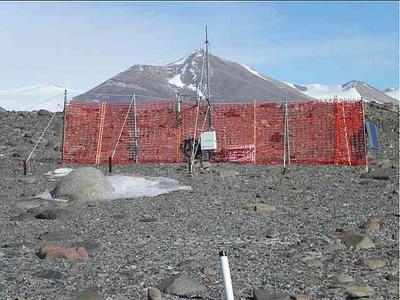14 January, 2003
The Wormherders
In 1903, Robert Falcon Scott wrote about the Dry Valleys, "We have
seen no living thing, not even a moss or lichen." The algae team
samples algae and moss at almost every stream, but Robert Scott
missed seeing other life here, too. I was lucky to be allowed to
visit the "Wormherders" in their lab at Crary in McMurdo. They are
studying nematodes which are a microscopic worm-like creature that
flourishes in the soils of the Dry Valleys.
Dr. Diana Wall from Colorado State, and Dr. Ross Virginia from
Dartmouth have teamed up to study the nematodes and their soil
habitat. The main goal of their work is to look at the processes in
this simple, but extreme, eco-system that control the diversity and
abundance of worms. Nematodes represent the top of the food chain in
the soils, and the food webs are very simple.
Three different species of nematodes are being counted in the
Wormherders' lab. They are looking at Scottnema, Eudorylaimus and
Plectus. They also count rotifers and tardigrades, two other
invertebrates found in the soils. As they look through their
microscopes, they tally the different species by whether they are
living, dead, male, female or juvenile.
An interesting fact about nematodes is that they take 300 days to
live their life cycle from egg to egg. That sounds like almost a
year, but each of those days requires the right temperature and level
of moisture for life, and those variables may take several years to
accumulate enough days to live the cycle. Nematodes are tolerant to
dehydration and freezing. Anhydrobiosis is the ability to withstand
the lack of moisture, and cryptobiosis is the ability to be tolerant
to both freezing and drying. Nematodes can be described with both
terms.
The Wormherders are asking how soil chemistry affects bio-diversity
of the nematodes. They are testing pH, salinity and conductivity of
the soils. Since there are no higher plants in the eco-system, they
are also asking from where the organic matter (carbon) is coming on
which the nematodes live. They are extracting carbon, nitrates,
phosphorus and ammonium which are common nutrients. They are looking
at the isotopic signature of carbon, which is the base of food
chains. Is it from the original ancient lakes, glacier melt, erosion
from rocks, wind sources, the oceans when sea levels rise, or a
combination? In other words, is the production of nutrients occurring
in the Dry Valleys, coming from ancient sources, or is it from plants
or other carbon sources transported by wind or water from outside the
valley?
In the field, several different experiments have been undertaken. A
snow fence has been built to capture the tiny bit of snow received
here. It's a simple, but effective way to introduce moisture to both
the soil and the air and to monitor its affect on the nematodes. The
Wormherders also water some of the worms with nutrients in the form
of sucrose and manitol. Temperature is manipulated by placing open
top chambers over the soil that act as mini-greenhouses as they
capture solar radiation.
As the information is gathered, and these small creatures are studied
and understood, it will be interesting to see what new questions will
emerge.

Byron Adams counts nematodes under a microscope.

Jeb Barrett, Dartmouth, works out logistics for trips to the field on the computer.

Diana Wall, Colorado State, washes soil from the nematodes, leaving them suspended in a sugar solution.

Jen Mercer, Dartmouth, tests the pH and salinity, of the soils.

Tom Cioppa, Brookdale Community College, uses a centrifuge to remove soil from the nematodes.

Chambers in the field that capture solar radiation like a greenhouse.

The open top of a chamber shows how moisture and light are not changed.

9. The snow fence was built to capture moisture in a natural way. The water enters the environment through both evaporation and melt into the soil.
Contact the TEA in the field at
.
If you cannot connect through your browser, copy the
TEA's e-mail address in the "To:" line of
your favorite e-mail package.
|
